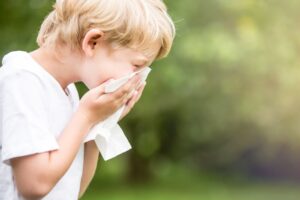Allergies in School-Aged Children
 Your immune system protects you from germs and diseases. Allergies are caused when your immune system reacts to something it recognizes as harmful, even though it is not harmful to most people. Pet dander, pollen, or certain foods can trigger your immune system, and reactions are different for each person and can range from mild to severe. Knowing how to recognize an allergic reaction can help you prepare in case of emergency.
Your immune system protects you from germs and diseases. Allergies are caused when your immune system reacts to something it recognizes as harmful, even though it is not harmful to most people. Pet dander, pollen, or certain foods can trigger your immune system, and reactions are different for each person and can range from mild to severe. Knowing how to recognize an allergic reaction can help you prepare in case of emergency.
Did you know…
A food intolerance (such as lactose intolerance) is not a food allergy. It does not involve the immune system and is not life-threatening. Usually, it happens because the food cannot be digested or absorbed. Symptoms are likely to be nausea, vomiting or diarrhea.
Prevention
The best way to stop an allergic reaction is to avoid the trigger. For example, with a pollen allergy, stay inside with windows closed when the pollen count is high. For an insect sting allergy, keep garbage covered and away from doors, and clean up sugary spills right away. For food allergies, read labels, and if you eat at a restaurant, let your server know of your allergens.
Recognizing an allergic reaction
The symptoms of an allergy differ from person to person, but there are common signs and symptoms. Emergencies can be reduced if the signs of a reaction are well-known.
Seasonal allergies (click to expand) »Seasonal allergy,or hay fever, is the most common type. The symptoms are like having a cold. Pollen from grass, weeds, flowers, and trees are the triggers.
|
Food allergies (click to expand) »Food allergies to wheat, nuts, milk, shellfish, fish, soy, and eggs are common. Most reactions will happen within 5-60 minutes. Symptoms include:
|
Drug allergies (click to expand) »Drug allergies to over-the-counter, prescription, or herbal medications can happen. Penicillin or sulfa drugs are examples of medicines that are more likely to cause a reaction. Symptoms include:
|
Insect sting allergies (click to expand) »Insect sting allergies can happen at the sting site or all over the body. Symptoms include:
|
Anaphylaxis (click to expand) »Anaphylaxis is the word used to describe a severe allergic reaction. It can happen very quickly and can cause death. Anaphylaxis can occur after a person:
Other triggers can also cause anaphylaxis; the symptoms can involve multiple body parts. The most common are:
Other anaphylaxis symptoms:
|
Treating an allergic reaction
Respond to an allergic reaction as quickly as possible. Antihistamines can effectively reduce the signs and symptoms of an allergic reaction. Anaphylaxis is life-threatening and requires the use of an epinephrine autoinjector.
Treating Anaphylactic Reaction
Don’t delay in giving epinephrine! That’s the most common mistake people make during anaphylactic reactions. Epinephrine is safe, and it can save a life. Never hesitate to use it.

MedicAlert®
A MedicAlert® bracelet lets others know about your allergy if you cannot talk. Parents should speak with their child’s teachers about preventing, recognizing, and treating allergies.
Check with your school to see if it is part of the MedicAlert® No Child Without program.
Involving your children
It would help if you taught your children to manage allergies by letting them know:
- Safe eating practices include handwashing before eating and not sharing/trading food.
- How to recognize the symptoms of a reaction.
- How and when to take medicines like antihistamines.
- If they have a life-threatening allergy, how to use an autoinjector and always carry it with them, depending on their age and ability.
Services related to this information:
- Contact your Public Health Nurse.
- 811 HealthLine (Newfoundland & Labrador) – Call 811 or 1-888-709-2929 / TTY 1-888-709-3555
- Speak with your doctor or nurse practitioner.

